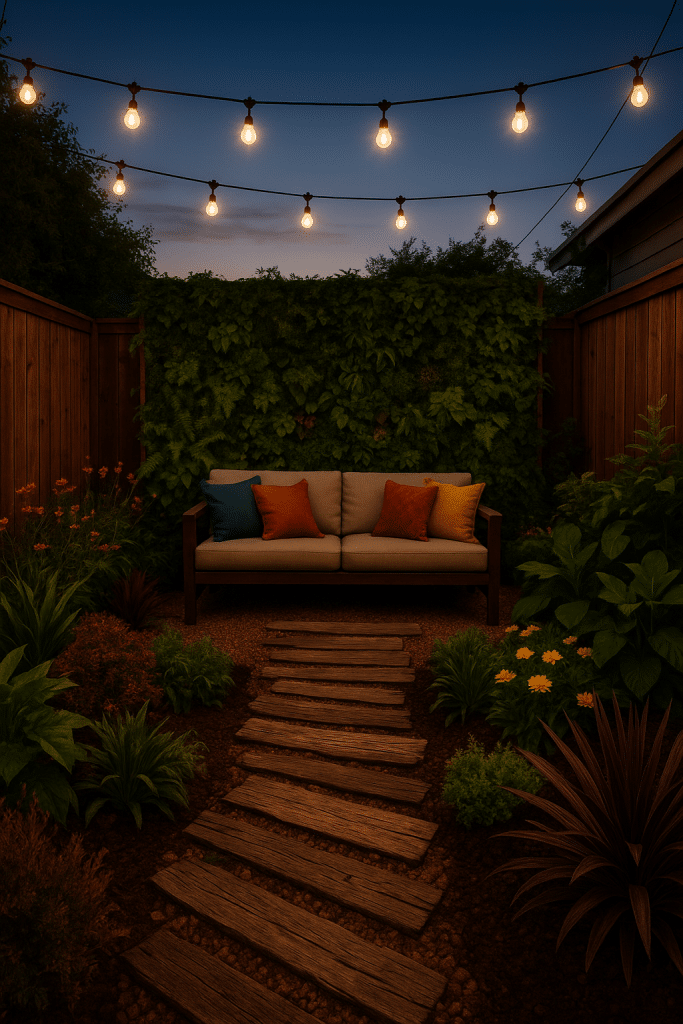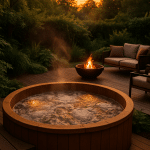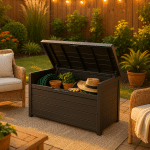If you’re a homeowner staring at a modest patch of land and wondering how to transform it into a vibrant retreat, you’re not alone. Small backyard design presents an exciting challenge, blending creativity and practicality to maximize every inch of outdoor space. Whether you’re dreaming of a calm garden nook, a lively entertaining spot, or a lush greenery haven, thoughtful design makes all the difference. Over the years, I’ve worked extensively with small yards and learned that with strategic planning and smart choices, any tiny backyard can become a dynamic living area that fits your lifestyle.
This article dives into five innovative small backyard design ideas that marry aesthetics with function. We’ll explore how embracing vertical gardening can flood your garden with greenery without demanding extra square footage. I’ll guide you on defining functional zones to make your small backyard feel larger and more purposeful. Plus, we’ll examine selecting compact, multi-functional furniture that optimizes your space without sacrificing comfort. You’ll also discover how layered landscaping with hardscape elements can add visual interest and depth. Lastly, we’ll look at enhancing ambiance through lighting, water features, and reflective accents to turn your outdoor sanctuary into a magical after-dark haven.
Whether you want creative small backyard design ideas or practical tips on how to maximize space in a small backyard, this guide is your blueprint for transforming limited outdoor areas into your favorite living spot.
1. Embracing Vertical Gardening for Maximum Greenery
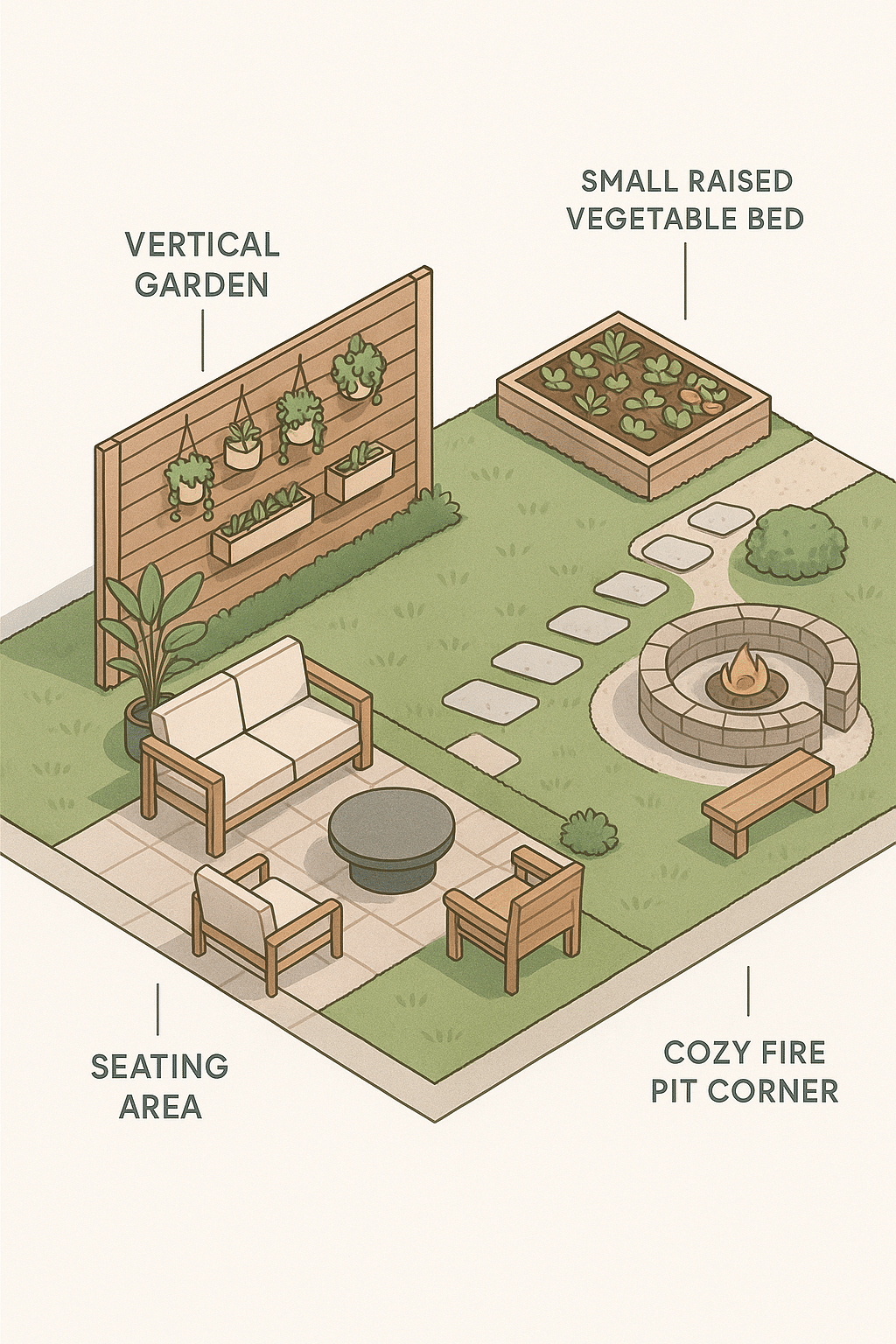
Vertical gardening has revolutionized how we think about planting in limited spaces. Rather than spreading outward, it encourages upward growth, making greenery possible even on compact sites.
Benefits of Vertical Gardening Systems in Small Spaces
Vertical gardening systems are a game changer. They allow you to add lush plant life without encroaching on floor space, which is often at a premium in small backyards. By employing trellises, wall planters, and vertical pots, you can create a vibrant green wall that acts as both a natural air purifier and a beautiful backdrop.
One standout benefit is improved privacy. Dense vertical gardens can obscure neighbors’ views and street noise, giving your outdoor area a peaceful, secluded feel. Many vertical gardens use modular panels or pocket planters, which are incredibly easy to maintain and ideal for growing herbs, flowers, and even small vegetables.
Choosing Climbing Plants and Wall-Mounted Planters for Privacy and Depth
When selecting plants for vertical gardens, prioritize climbers and trailing plants that can quickly cover structures and bring depth. Clematis, star jasmine, climbing roses, and ivy are excellent options due to their vigorous growth and beautiful foliage or flowers. For a truly fragrant oasis, honeysuckle or jasmine provide sweet scents.
Integrating wall-mounted planters also lets you mix annuals and perennials, offering seasonal interest without crowding the floor. Think of colorful petunias, succulents, and ferns—each can thrive and create layers of texture against a fence or side wall.
Integrating Outdoor Pergolas and Trellises to Enhance Vertical Appeal
To take your vertical gardening to the next level, add structures such as pergolas and trellises. These not only support climbing plants but also define outdoor seating zones beneath shaded canopies. A pergola draped with wisteria or grapevines provides dappled shade during sunny afternoons and frames your space beautifully.
Similarly, free-standing trellises can partition your yard into private nooks or visually enlarge it by drawing the eye upwards. With the right plants and structures, you harness vertical gardening to create an immersive, green sanctuary that feels much larger than its footprint.
2. Defining Functional Zones to Multiply Usable Space
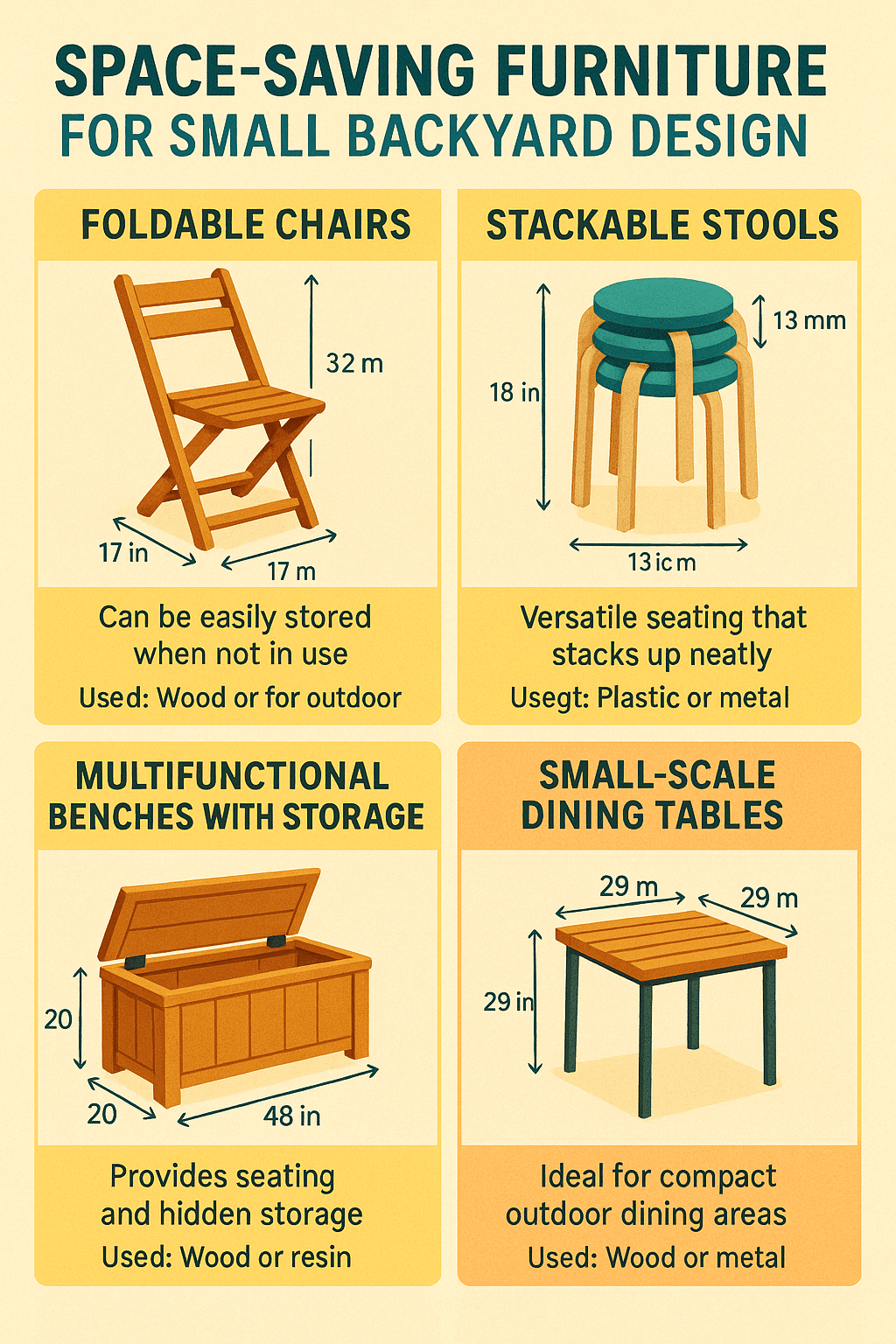
Small backyard design isn’t just about fitting things in—it’s about making the area work harder for you. Defining clear zones for different activities extends your outdoor living potential exponentially.
How to Plan Garden Zoning and Layout for Small Backyards
Start by visualizing what outdoor activities are most important to you: relaxing, cooking, gardening, playing, or socializing. Then map out where these will happen relative to your home’s doors, sunlight paths, and existing features.
For example, situate a dining space near the kitchen door for easy access, while placing a cozy lounge area in a quiet corner shielded by plants or screens. Using rugs, pavers, or decking in varied materials makes it easy to delineate these zones visually and functionally.
Creating Multi-Use Outdoor Rooms with Patios, Decking, and Raised Garden Beds
In a small yard, each zone can perform double duty. Raised garden beds can border a patio, providing greenery while acting as informal seating or boundaries. Similarly, multi-level decking creates pockets for dining and lounging without overwhelming the space.
Think of your backyard as a collection of rooms without walls—patios become your “dining room,” decking your “living room,” and garden beds your “art gallery.” This layering brings sophistication and comfort, making the entire area feel larger and more versatile.
Small Backyard Design with Privacy Screens and Delineated Activity Areas
Privacy is crucial in compact backyards. Strategically placed screens—made from bamboo, lattice, or even fabric—offer separation and intimacy without crowding. Combining these with greenery softens their look and enhances the sense of enclosure.
You might also use planters filled with tall grasses or shrubs as movable dividers. This flexibility accommodates shifting uses, like opening the space for a family barbecue or sectioning off a quiet reading corner.
3. Selecting Compact, Multi-Functional Furniture to Optimize Space
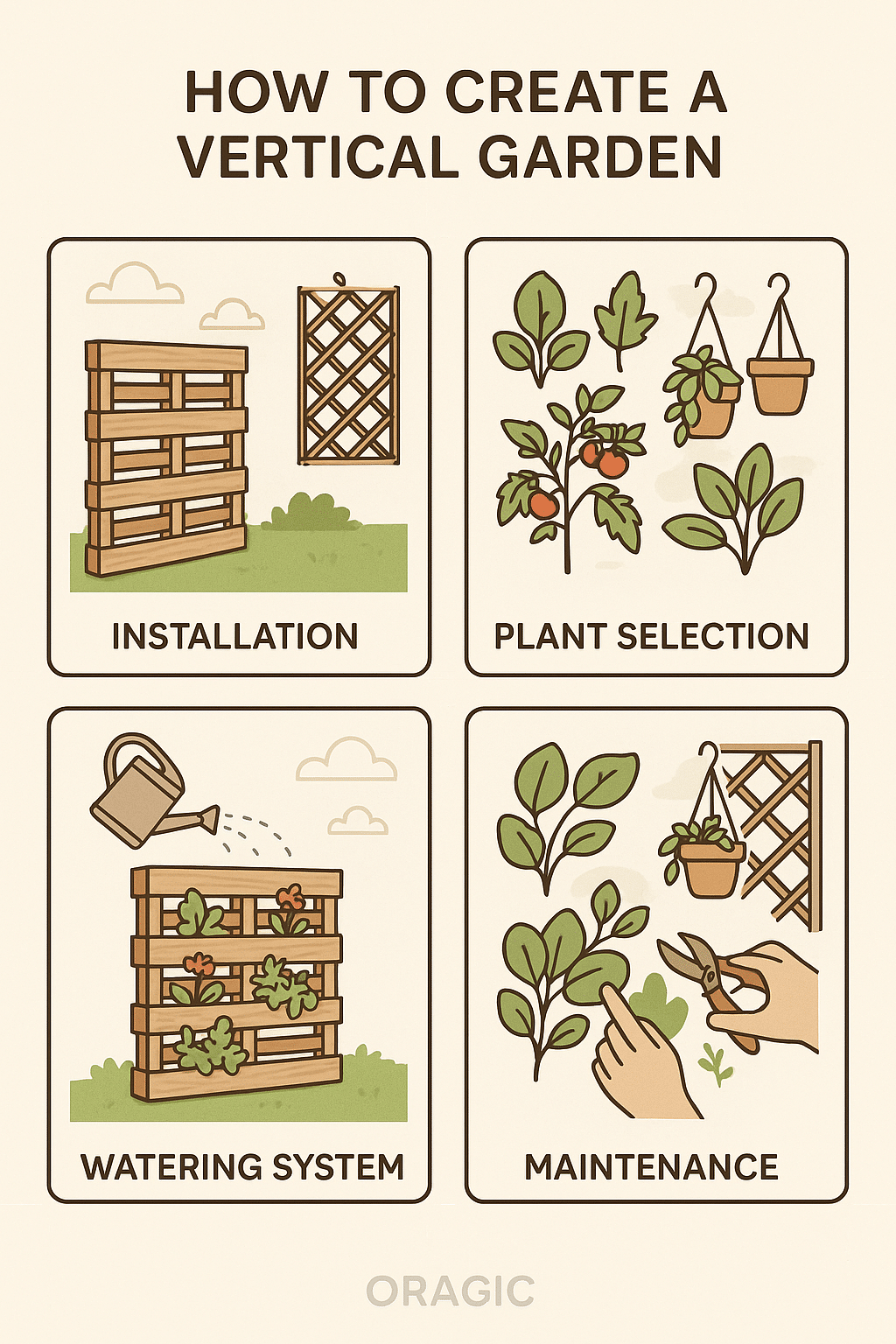
When space is scarce, furniture must pull double duty—and look good doing it.
Features of Multi-Use Outdoor Furniture for Small Backyards
Look for furniture with built-in storage to hide cushions or garden tools, fold-away options to clear the deck when needed, and modular pieces that adapt to various activities. For instance, a bench with a hollow base works as both seating and storage, while stackable chairs fit neatly when not in use.
Materials like powder-coated steel, weather-resistant wicker, or teak ensure durability and easy maintenance, essential in outdoor settings.
Space-Saving Furniture Ideas: Foldable, Stackable, and Storage-Integrated Options
Space-savers such as foldable tables and chairs let you adjust seating based on guest count. Stackable garden stools are another smart choice—they’re easy to tuck away but stylish enough for regular use.
Storage ottomans provide cozy footrests and compartments for outdoor cushions or kid’s toys. Even a convertible picnic table, which turns into a bench, maximizes usability without crowding.
Using Pergolas to Define Seating Areas and Provide Shelter
Adding a pergola—or even a pop-up canopy—over your furniture zone increases comfort and extends the usability of your backyard by providing shade and shelter. With weatherproof curtains or retractable screens, you can create a microclimate perfect for both sunny days and cooler evenings.
The frame also serves as a base to hang soft string lights or lanterns, uniting ambiance and function beautifully.
4. Layered Landscaping and Hardscaping for Depth and Interest
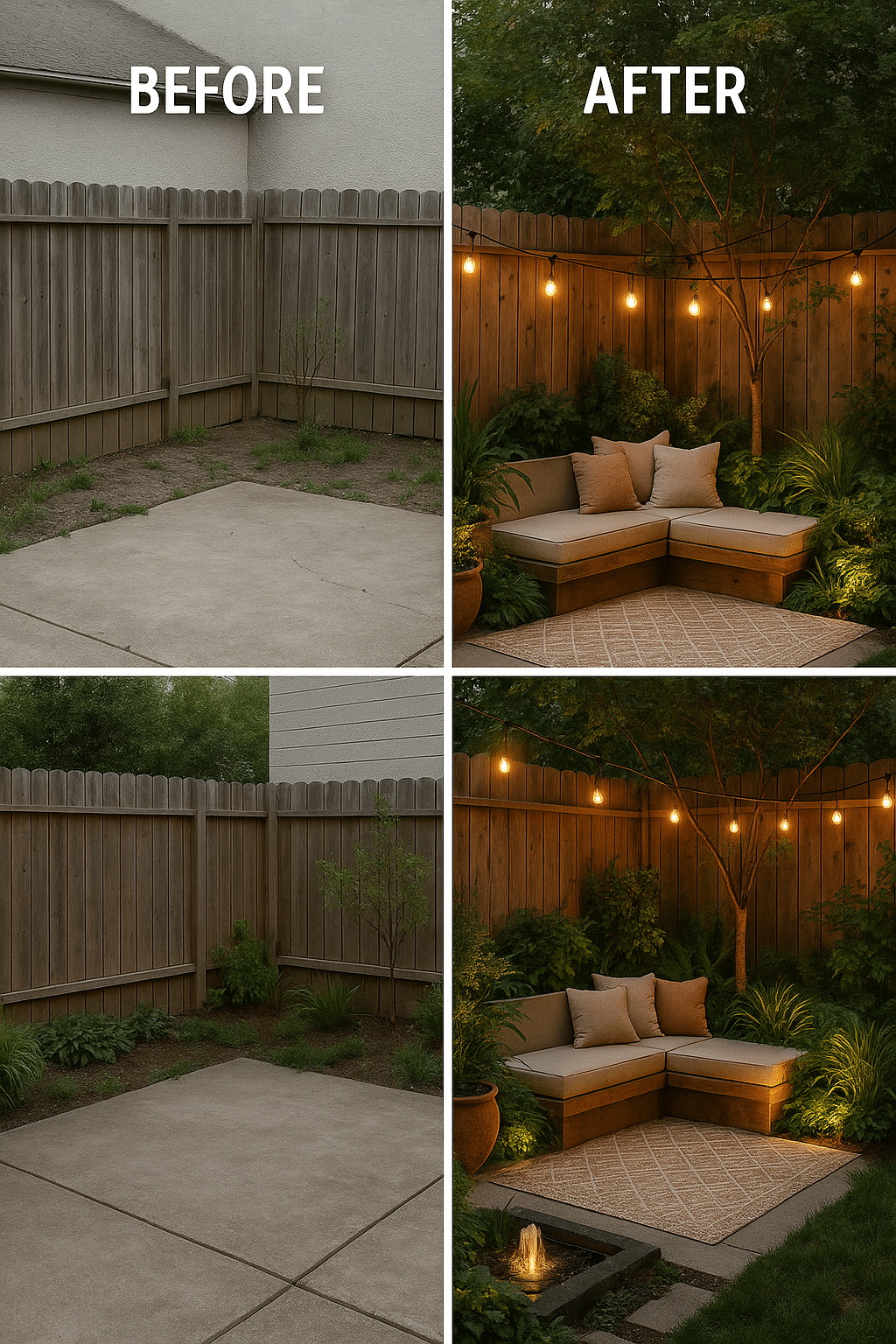
To visually expand your small backyard, layering plants and hardscape materials is key.
Combining Ornamental Grasses, Compact Perennials, and Shrubs for Texture
Mixing textures adds depth and keeps your garden engaging, even if it’s compact. Ornamental grasses gently sway in the breeze, compact perennials like lavender and sedum bring color and scent, and small shrubs offer structure.
For example, a trio of pennisetum grasses, creeping thyme ground cover, and boxwood shrubs creates a lush foundation with year-round visual interest.
Using Tiered Beds and Raised Planters for Layered Planting Design
Multiple planting levels trick the eye into perceiving more space. Tiered beds utilize vertical height; you can build low stone retaining walls or raised planters that step up toward fences or walls.
Raised beds improve soil drainage and accessibility, letting you grow a wider variety of plants efficiently. Their clean lines also help organize the space, reducing cluttered feelings.
Incorporating Hardscape Materials: Pavers, Gravel, Stone Pathways, and Patios
Hardscape adds dimension and guides movement through your garden. Using a combination of natural stone pavers, gravel borders, and flagstone patios can break up the backyard into purposeful sections while keeping design continuity.
For instance, a gravel pathway edged with lavender plants can wind through your garden, connecting seating and planting areas. Different textures, colors, and heights in hardscaping bring an inviting layered effect that magnifies your space’s appeal.
5. Enhancing Ambiance with Lighting, Water Features, and Reflective Elements
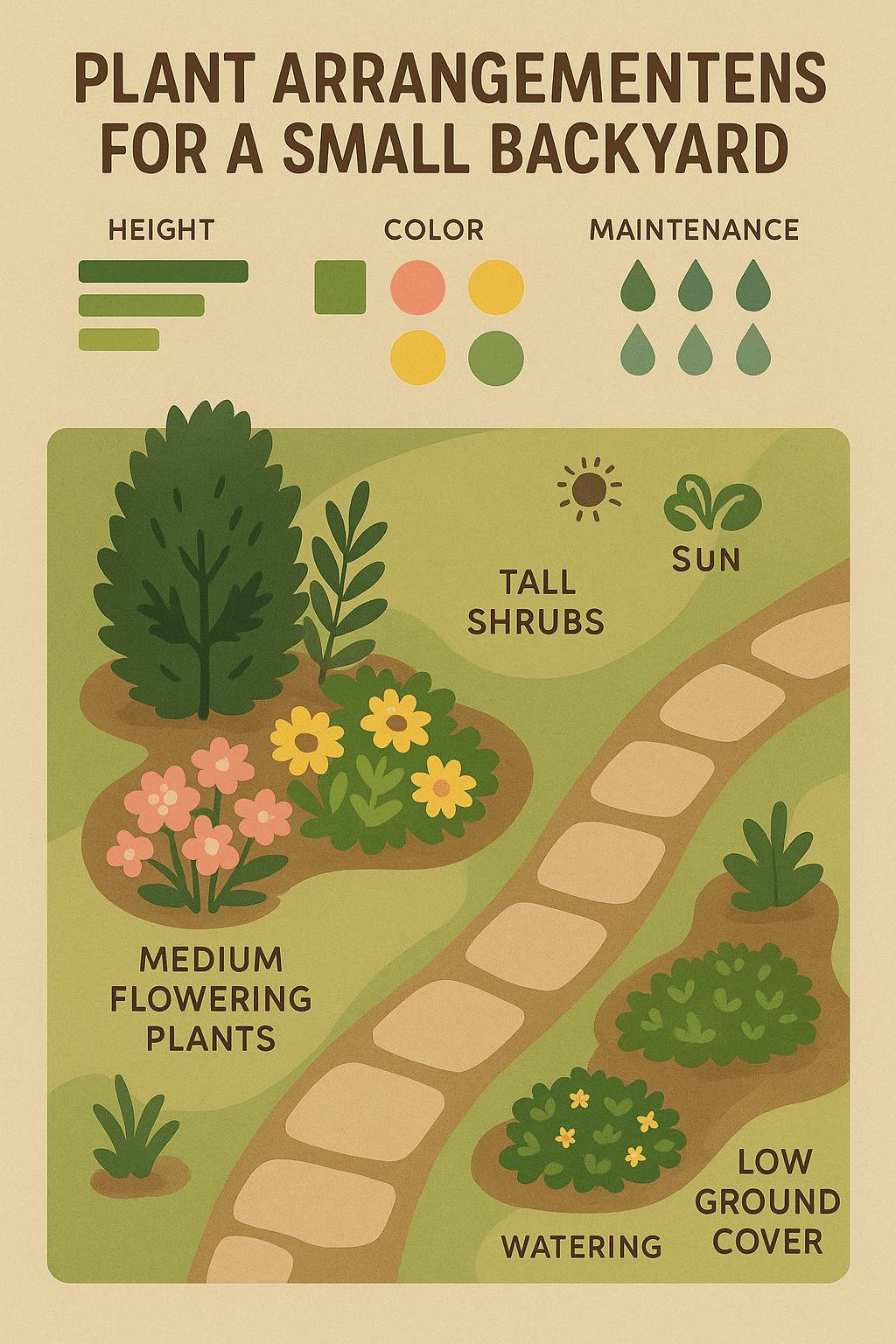
The right ambiance makes a small backyard feel welcoming and spacious both day and night.
Landscape Lighting Solutions: String Lights, LED Candles, and Lanterns
Lighting sets the tone for outdoor living after sunset. Soft string lights draped overhead add warmth and magic. LED candles in glass holders or solar-powered lanterns highlight pathways and seating zones without harsh glare.
Consider layering different light sources—some subtle, some bright—to illuminate key spots like dining tables, steps, or plant clusters. Smart lighting systems can even adjust brightness or color on demand through phone apps.
Small Backyard Water Feature Ideas: Fountains, Ponds, and Tranquil Soundscapes
Water features bring sensory delight and peaceful soundscapes. Compact fountains recirculate water, requiring minimal maintenance and no large space. Wall-mounted water panels are perfect for tight spots.
If you have slightly more room, a small pond or built-in basin with aquatic plants and floating lights can become a central feature. The sound of trickling water not only masks unwanted noise but also enhances relaxation.
Using Mirrors and Reflective Garden Design Elements to Amplify Space
Incorporating reflective materials such as garden mirrors, shiny stones, or metal sculptures tricks the eye, creating illusions of depth and doubling perceived size. Placing mirrors near plantings or facing a bright area amplifies light and opens the visual space.
Reflective pots and glass ornaments add small flashes of brightness, guiding visitors’ attention and elevating the character of your small backyard.
FAQs
Q1: What are the best plants for small backyard spaces to maximize greenery without crowding?
A: Compact perennials like lavender, sedum, and ornamental grasses, along with small shrubs such as boxwood or dwarf hydrangeas, work well. Climbing plants like clematis and jasmine suit vertical gardening, which saves ground space.
Q2: How can I maximize space in a small backyard using furniture?
A: Opt for multi-functional pieces such as benches with storage, foldable chairs, and stackable tables. Modular furniture allows flexible layouts, supplementing seating without cluttering.
Q3: What are some effective privacy solutions for small backyards?
A: Combining garden privacy screens, tall planters with shrubs or grasses, trellises with climbing plants, and pergolas with fabric curtains delivers privacy and style in confined yards.
Q4: How can I maintain layered landscaping in a small garden without making it look crowded?
A: Use tiered bed designs with clean edges, select plants varying in height and texture but limited in number, and keep pathways clear to avoid a cluttered feel.
Q5: What lighting options enhance small backyard spaces for evening use?
A: String lights, solar-powered LED lanterns, pathway lights, and subtle uplighting on plants create warmth and ambiance, making the space feel larger and more inviting after dark.
Quick Takeaways/Key Points
- Vertical gardening maximizes greenery without using floor space and adds privacy.
- Defining distinct functional zones in your small backyard increases versatility and usability.
- Compact, multi-functional furniture saves space and adapts to changing needs.
- Layered landscaping with a mix of plants and hardscape materials adds depth and interest.
- Thoughtful lighting, water features, and reflective elements elevate the backyard’s ambiance.
- Privacy screens combined with plants help create intimate outdoor retreats.
- Incorporating sustainable, eco-friendly materials supports long-term garden health.
Conclusion
Designing a small backyard to be both beautiful and functional isn’t just a dream—it’s completely achievable with the right approach. By embracing vertical gardening, zoning outdoor spaces thoughtfully, using compact furniture, layering landscaping elements, and ingeniously enhancing ambiance, you can transform even the tiniest yard into a stunning creative outdoor living area. The key is to plan carefully, select multi-purpose components, and personalize the space to your preferences. As a homeowner seeking creative small backyard design ideas, adopting these strategies offers a rewarding way to maximize your home’s outdoor potential and create a sanctuary you’ll love returning to everyday.
Ready to start your small backyard transformation? Begin with a clear vision of how you want to use your space and experiment with vertical gardening and zoning first. The rewards—a cozy, inviting garden that feels larger and more lively—are well worth the effort. Let your small backyard become a reflection of your style and a favorite spot to unwind or entertain all year round!

